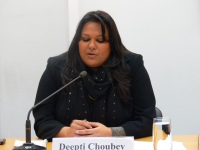Registration
You will receive an email confirming your registration.
IMGXYZ2376IMGZYXTwo potentially conflicting imperatives drive Barack Obama’s nuclear agenda. On the one hand, he has called for a world free of nuclear weapons. On the other hand, he believes that the United States needs credible nuclear deterrence. The balance between the two is uneasy, according to Deepti Choubey, deputy director of the Nuclear Policy program of the Carnegie Endowment for International Peace.
Speaking at the Carnegie Moscow Center, Choubey described the key issues on President Obama’s nuclear agenda (the START I follow-on treaty, the Nuclear Posture Review, the NPT Review Conference and the CTBT) and the role of U.S. domestic politics in determining his strategy for achieving that agenda. Carnegie Moscow’s Alexei Arbatov moderated.
Non-Proliferation Treaty (NPT) Review Conference
Looking forward to the NPT Review Conference in May 2010, Choubey expressed confidence that, even if a consensus final declaration was not possible, the nonproliferation regime will not be undone. Her optimism was echoed by audience member Ambassador Jaap Ramaker (Netherlands), chair of the 1996 Nuclear Test-Ban negotiations and special representative of states ratifiers to promote the ratification process of the CTBT (2003-2009).
- During the Conference: Arbatov argued the conference must achieve tangible results, or the nonproliferation regime will emerge weakened and in danger of disintegration. He suggested one such result would be the universalization of the 1997 IAEA Additional Protocol. Choubey suggested that the focus should be on achieving consensus on the issues where the Review Conference has a comparative advantage versus other decision-making bodies in the broader nonproliferation regime. She also listed several concrete steps states at the Review Conference could take to show that there is positive momentum to further strengthen the regime after the Review Conference.
- After the Conference: Ramaker stated that it is important to think about what must be done after the conference ends, rather than focusing on the indicators by which the conference’s success or failure can be measured.
